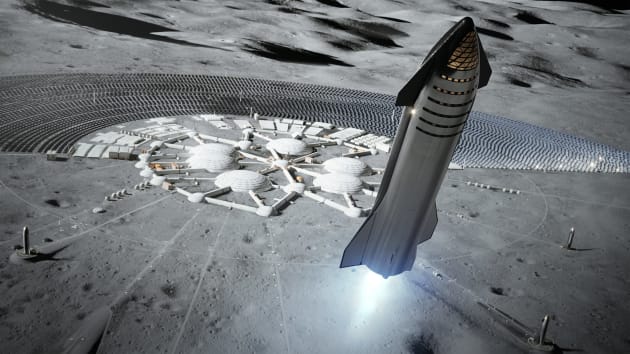

Artist’s rendering of a SpaceX Starship rocket on the Moon. Image credit: SpaceX
SpaceX’s latest prototype of SpaceX’s next-generation Starship rocket has had another successful launch, but the landing proved to be a problem again.
Just like a similar launch in December, the next-generation Starship rocket launched successfully on Tuesday for another test flight, but exploded on impact during an attempted landing.
SpaceX had first revealed MK1 of the giant stainless-steel space vehicle to the world back in September 2019. The Starship is designed to ferry dozens of passengers to the Moon and Mars, in line with a long-term NASA project called Artemis.
The Starship rocket is designed to ultimately be used with SpaceX’s Super Heavy booster rocket.
Indeed, Elon Musk has already signed up his first commercial passenger, Japanese billionaire Yusaku Maezawa, who wants to fly around the Moon and back with a group of artists.
But testing continues and SpaceX this week launched Starship prototype Serial Number 9 (or SN9), which sought to fly as high as 10 kilometers, or about 32,800 feet altitude.
The flight was similar to the one SpaceX conducted in December, when it launched prototype SN8 on the highest and longest flight to date, CNBC reported.
And just the December rocket, SN9 also hit the ground explosively on its return.
“We had, again, another great flight up … we’ve just got to work on that landing a little bit,” SpaceX principal integration engineer John Insprucker was quoted as saying, on the company’s webcast of the flight.
The rocket prototypes are built of stainless steel, and will be able to carry both cargo and as many as a 100 people at a time on missions to the moon and Mars.
While SpaceX’s fleet of Falcon 9 and Falcon Heavy rockets are designed to be partially reusable, Musk’s goal is to make Starship fully reusable.
Indeed, his vision is of a rocket that is more akin to a commercial airplane, with short turnaround times between flights where the only major cost is fuel.
In June last year, SpaceX and NASA made history with the first manned flight to the International Space Station carried out by a private company.
The launch of SpaceX’s Falcon 9 booster rocket, carrying its Crew Dragon capsule, meant that the United States regained the ability to launch astronauts into space, following the cancellation of NASA’s space shuttle program in 2011.
Following the success of sending two NASA astronauts to the International Space Station last year, Musk reportedly declared the Starship rocket his ‘top priority.’
This week SpaceX announced that it will put, for the first time ever, an all civilian flight crew into orbit later this year.
The announcement of the Inspiration4 mission will be the first-ever orbital flight crewed entirely by non-astronauts, and will be funded by Jared Isaacman, founder of CEO of payment processing startup Shift4 Payments.
In November last year SpaceX and NASA successfully delivered another four astronauts on board the International Space Station (ISS).
Dozens of Chinese firms added to US export blacklist, in order to hamper Beijing's AI…
Chinese rival BYD overtakes global revenues of Elon Musk's Tesla, as record number of Tesla…
Messaging app Signal in the headlines after a journalist was invited to a top secret…
OpenAI chief operating officer Brad Lightcap to oversee international expansion as company consolidates lead in…
Chinese researchers publish details on device that could wreak havoc on undersea communications cables in…
Former Intel chief Gelsinger expands role at Gloo, becoming executive chairman and head of technology…